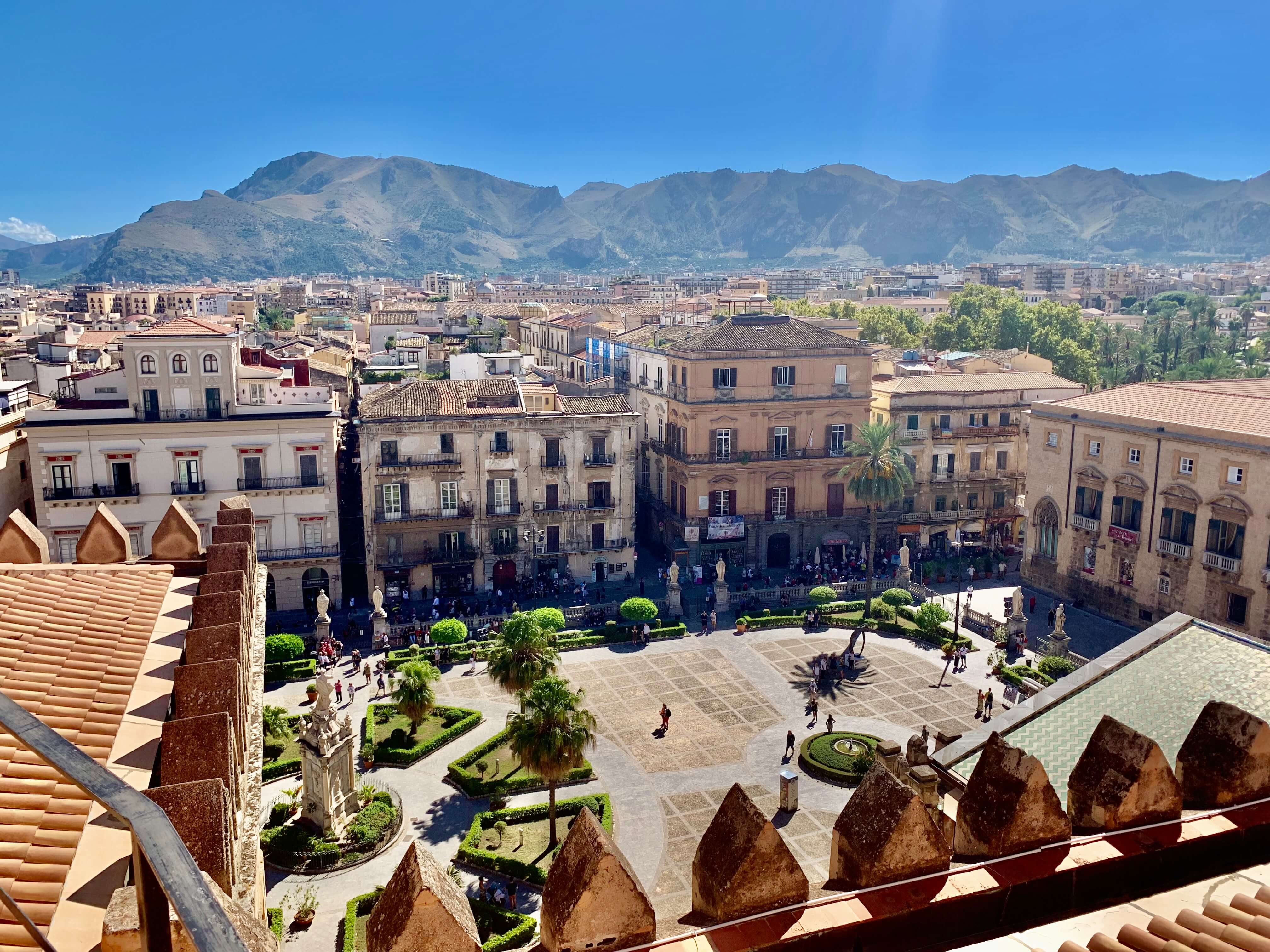- Home
- Things to Do in Sicily
- Etna Mountain
Exploring the Majestic Etna Mountain: A Journey into Sicily's Fiery Heart
Welcome to the fiery heart of Sicily, where majestic beauty meets unstoppable power. Over the eastern part of the island looms the legendary Etna Mountain. This ancient volcano has shaped the landscape and culture of the region for millennia.
Rising over 10,000 feet above sea level, Mount Etna can surely be described as Sicily's biggest attraction - literally. It is Europe's highest and most active volcano.
This means that it often erupts, which is one way it affects the lives around it. Its most dramatic eruptions have terrorized and fascinated generations, leaving a breathtaking legacy of lava and ash-covered landscapes.
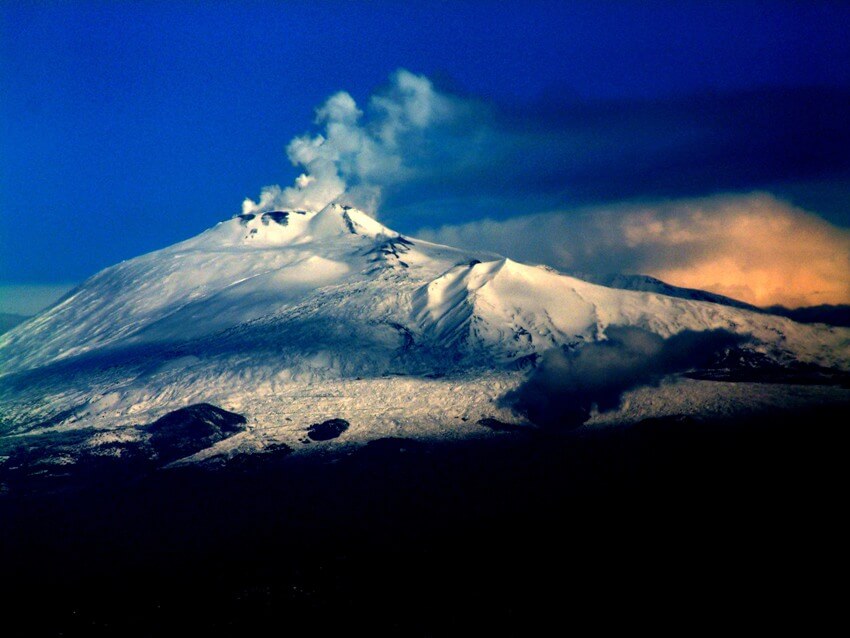 Etna Mountain (Photo: Josep Renalias / Wikimedia Commons)
Etna Mountain (Photo: Josep Renalias / Wikimedia Commons)Luckily, Etna Mountain's usual activity doesn't cause too much trouble for people living nearby. In the towns on its slopes, residents must clean ash off their terraces, and Catania Airport may occasionally have to suspend its flights.
Only 77 people have ever been killed because of eruptions during 3,500 years of its recorded activity.
But Mount Etna affects the people around it, not just through eruptions. Its surroundings have been a popular place to live for thousands of years, and even today, one-fifth of Sicily's population lives around it.
The mountain's volcanic slopes are an ideal growing environment for many plants, from citrus fruits to pistachios. From the lush vineyards that produce Sicily's world-class wines to the unique plants and wildlife, Etna teems with surprises.
Etna Mountain also has a rich history and cultural significance extending to ancient Greek and Roman times. Today, the mountain's presence continues to influence the charming hilltop villages and local traditions. These include unique festivals, traditional crafts, and culinary practices shaped by the volcano's fertile soil and the challenges of living in its shadow.
Etna has been a UNESCO World Heritage site since 2013.
Geological Grandeur of Mount Etna
Etna originated under the sea, from there it has risen to its present height in half a million years under the force of tectonic plates.
Rising majestically from the eastern coast of Sicily, Etna is a composite volcano of layers of hardened lava, ash, and rock fragments from countless eruptions.
Etna Mountain has a broad base the size of London. From there, its slopes rise gradually until getting steeper and forming its symmetrical cone. This shape is characteristic of this type of volcano, which is known for its explosive and effusive eruptions.
The mountain's summit, which reaches an impressive height of over 10,900 feet (3,350 meters), is capped by a large, central crater, surrounded by several smaller subsidiary craters that have formed over time.
Many eruptions occur on the sides of the mountain. These "flank eruptions" create spectacular displays of lava flows and ash plumes that have captivated and terrified onlookers since time immemorial—and still do.
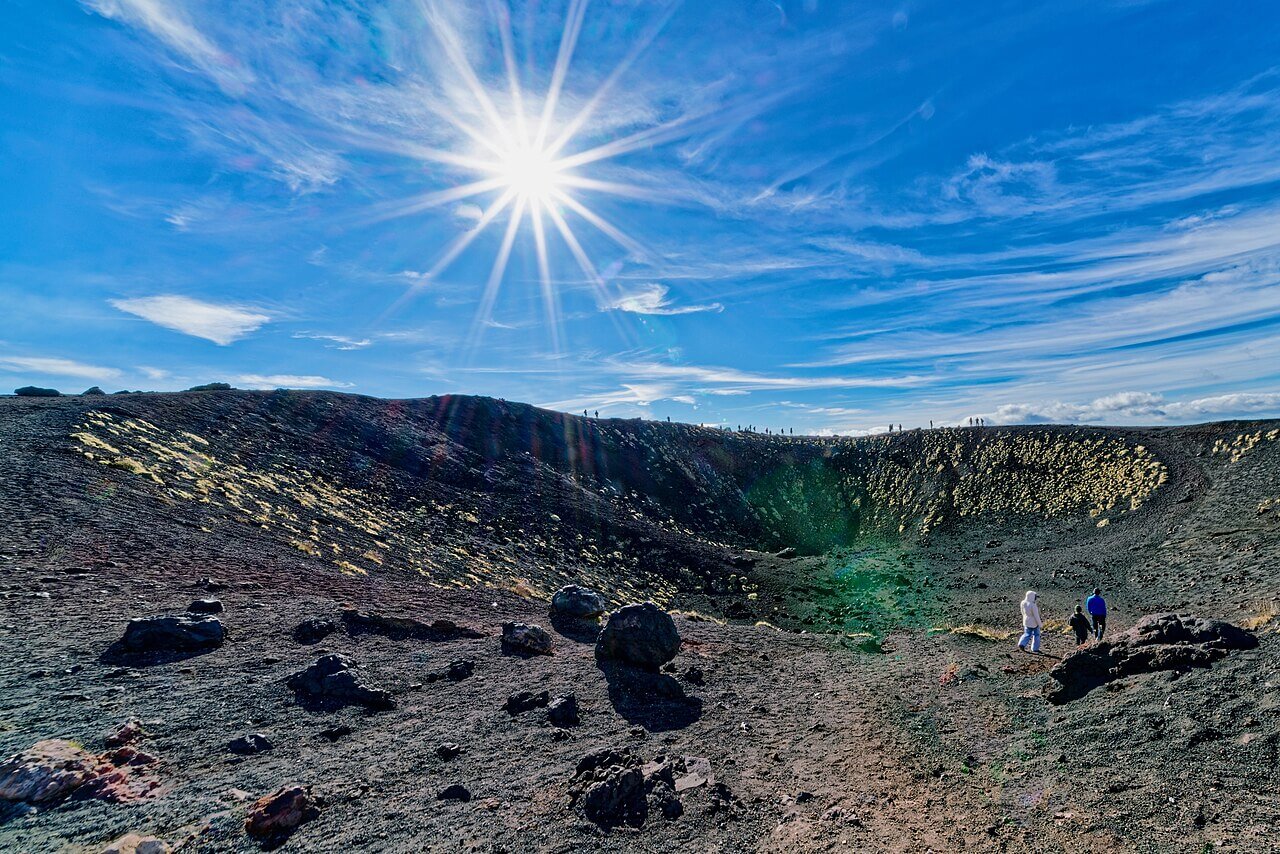 One of the side craters on Mount Etna. (Photo: Holger Uwe Schmitt / Wikimedia Commons)
One of the side craters on Mount Etna. (Photo: Holger Uwe Schmitt / Wikimedia Commons)Historical Significance of Mount Etna
Etna's earliest recorded eruptions date back to the 7th century BCE, when ancient Greek settlers began colonizing the area.
For the ancient Greeks and Romans, Etna was a sacred and fearsome entity associated with the mythological figure of Vulcan, the god of fire and blacksmiths.
The volcano's dramatic eruptions were seen as a manifestation of Vulcan's forge, where he was said to toil endlessly, forging the gods' weapons.
In the Middle Ages and Renaissance, Etna's eruptions continued to captivate and terrify the local population. Despite the constant threat, they often sought refuge in the mountain's many caves and lava tubes during crises.
The volcano's destructive potential was also recognized by the ruling powers of the time, who sought to harness its energy for their own ends, using the mountain's resources for everything from building materials to defensive fortifications.
Even today, many houses in Catania are built of lava stone - in case you wondered why they look so dark.
Today, Etna Mountain's unique geological features have made it a popular destination for scientists and researchers studying its complex and ever-changing landscape, as well as tourists, hikers, and adventure-seekers.
At the same time, the mountain's fertile slopes and temperate climate have supported the growth of a thriving agricultural industry, with local producers crafting world-renowned wines, olive oils, and other delicacies that bear the distinct flavors of Etna's terroir.
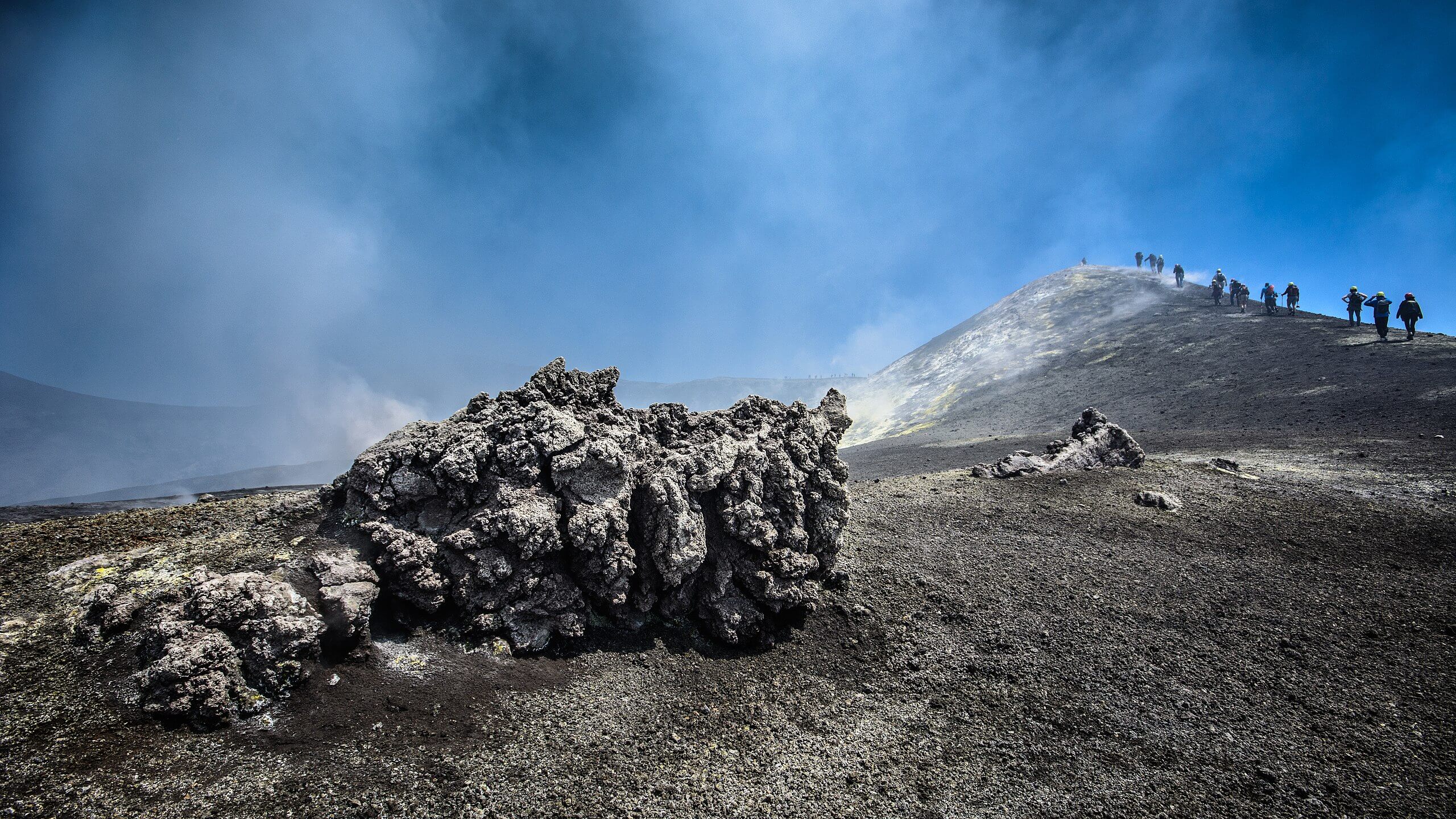 Hiking party on Mount Etna. (Photo: kuhnmi / Wikimedia Commons)
Hiking party on Mount Etna. (Photo: kuhnmi / Wikimedia Commons)How to Visit Mount Etna?
Before a visit to Etna Mountain it is worth to consider your interests. Which is more important, the vineyards or the views? How much exercise are you prepared to do? There's an easy - yet rewarding - scenic route, or you can climb higher - all the way to the top.
The wineries on the slopes of Etna are on the north and east sides of the mountain, while the climb to the craters is from the south. While it is possible to visit both the wineries and the craters in a day, it requires careful planning and favorable weather conditions. These are not to be taken granted.
Alternatively, you can opt for a tour operator to organize a comprehensive package. Less stress, more satisfaction, but requires a bit more money.
How to Get to the Top?
The ascent to Etna mountain begins from Rifugio Sapienza, approximately an hour's drive from Catania. At Sapienza, you are presented with two choices. Will you set your sights on the summit or opt for the easier and quicker route to the lower craters?
You can take a cable car, bus, or hike to go higher. The hike to the top takes several hours and requires at least moderate physical fitness.
It pays to be on the move early if you're aiming for the top. The longer the day lingers on the more foggier the weather and more crowded Rifugio Sapienza.
The last treks to the top leave at 10:30 am. Climbing there on your own is not allowed.
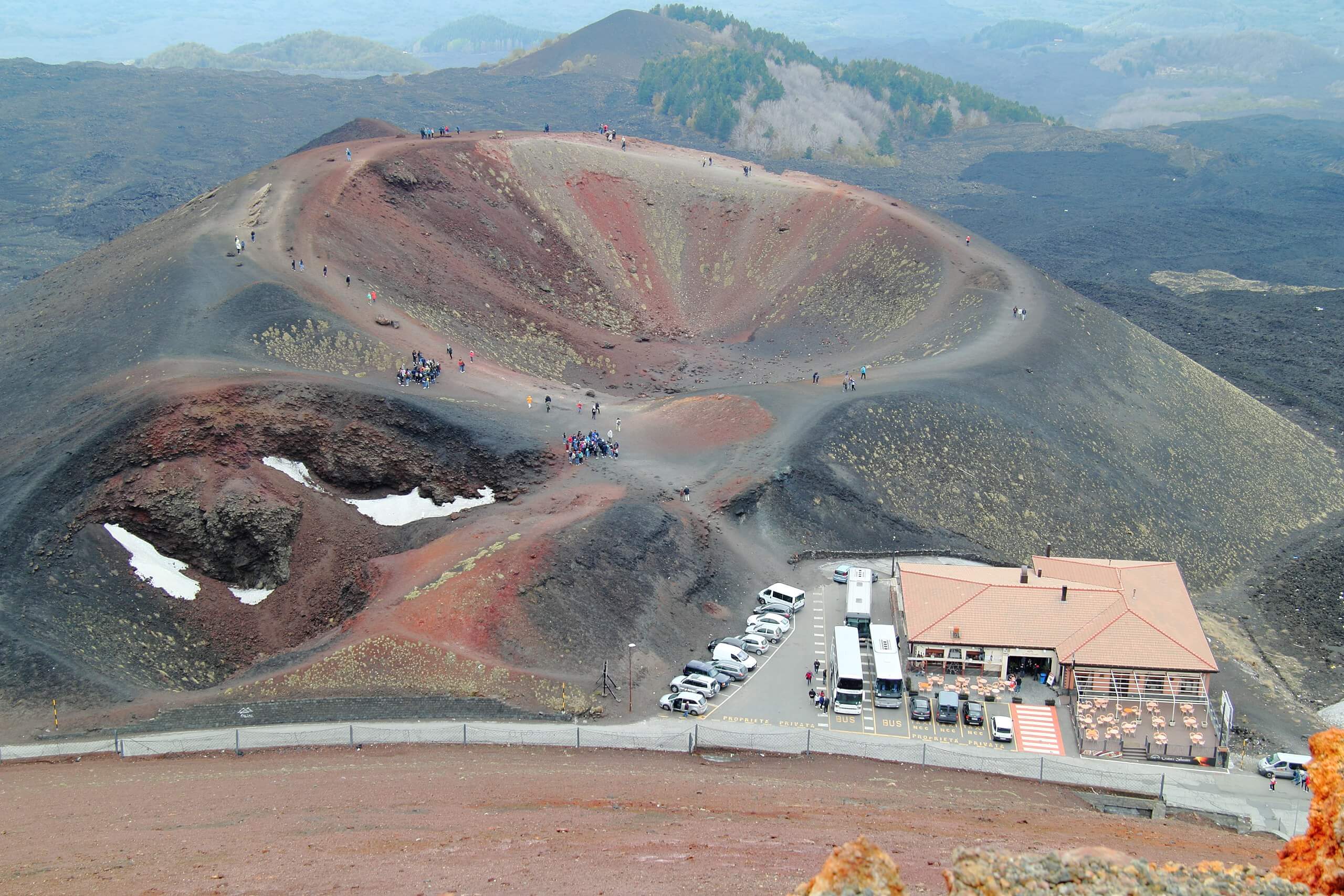 Rifugio Sapienza (Sabe! / Wikimedia Commons)
Rifugio Sapienza (Sabe! / Wikimedia Commons)Hiking Opportunities on Mount Etna
There are three hiking options to Etna. The first is quick and easy. From Rifugio Sapienza, there are two hiking trails to two different side craters.
These are the upper and the lower Silvestri craters. The lower one is easier to reach, and there is little climbing. The journey to the crater and back takes less than an hour.
The upper Silvestri requires more climbing. The hike there and back also takes less than an hour. Both Silvestri are easily accessible on your own.
If you want to go higher, you can take a cable car. From its upper station, you, again, have two options: go to the top or set your sights a little lower.
There are 4x4 buses available to take you up to 9,800 feet. You can only go up there with a guide. This is the easiest way to get as high as possible without hiking much.
The summit of Etna is at 10,800 feet. Group hikes are available at the cable car station. Bring your food and warm clothes with you.
The journey to and from the central crater takes 5-6 hours. Here, as in Sapienza, the last hike starts at 10.30 am.
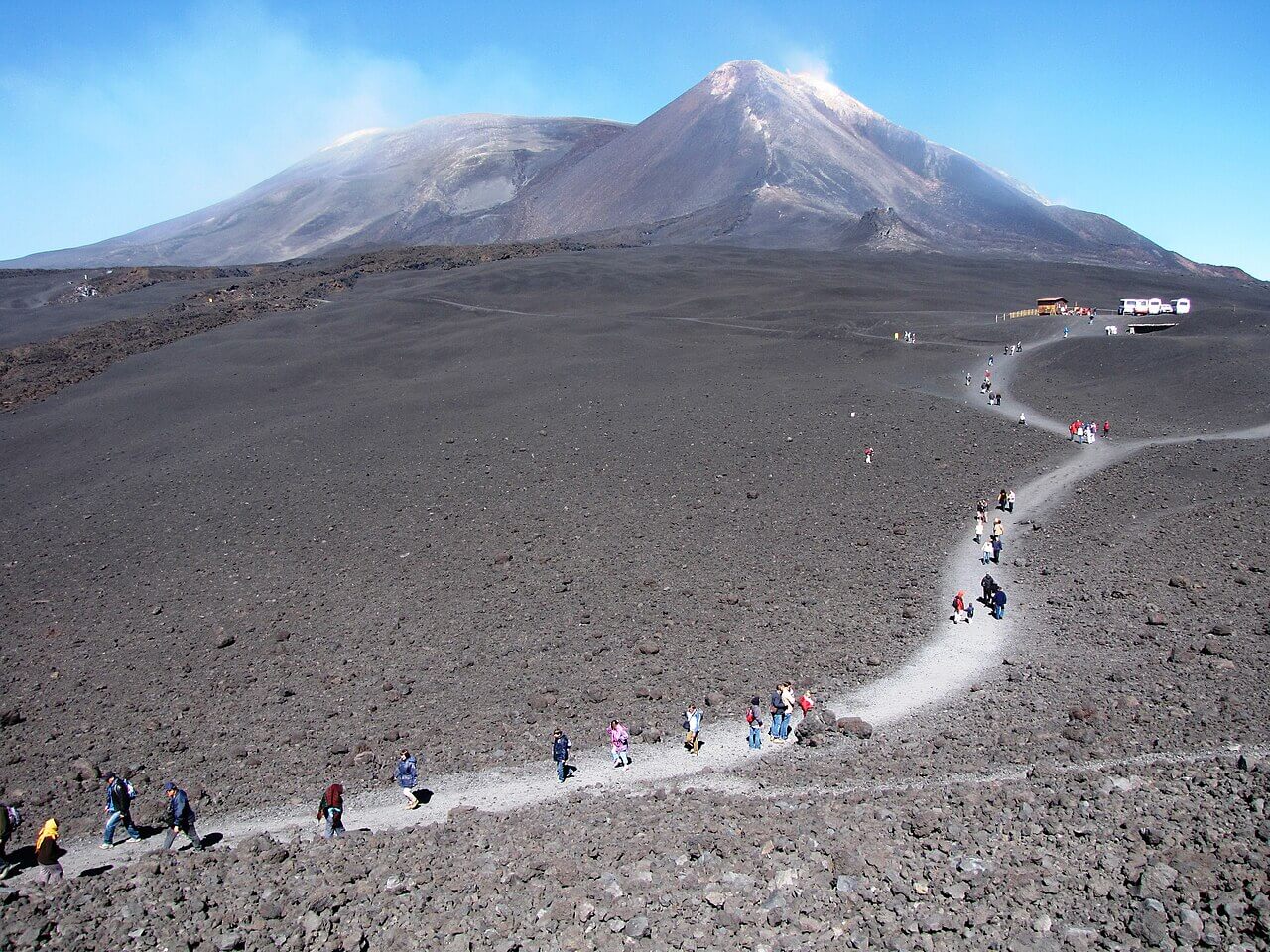 (Hein56didden / Wikimedia Commons)
(Hein56didden / Wikimedia Commons)When to Visit
Mt. Etna can be visited and hiked year-round. For the hike, the best season is from March to September. If you want to avoid crowds, consider spring or autumn.
Weather conditions change rapidly on the mountain. As you go up, you go from a Mediterranean coastal to an alpine climate. Etna collects rain clouds, so the weather can change rapidly even at the same altitude.
Winds can also pick up quickly. If the wind is strong, the cable car will not move. Organized excursions are also subject to weather reservations. Therefore, knowing the situation on any given day is worth it. The volcano's activity may also affect your plans.
So, to avoid disappointment and fruitless trips, it's worth checking both the weather on the mountain and the volcano's current activity.
What to Wear When Climbing Mount Etna?
The most important thing when climbing Mount Etna is to have good shoes. The terrain is far from flat, and depending on the nature of the hike, there can be a lot of walking and climbing.
The higher you go, the thinner and colder the air will be. A rainproof jacket is a good idea. Dress warmly and in layers, allowing you to adjust clothing as needed.
A hat, gloves, and sunglasses may come in handy—sunglasses not just for the sun but also because wind-blown lava dust can get to your eyes.
Local Wineries on the Slopes of Etna Mountain
Mount Etna's presence has profoundly impacted the region's rich culinary and cultural traditions.
One of the most notable culinary delights emerging from Mount Etna's shadow is the region's world-famous wines. The volcano's unique microclimate and mineral-rich soils have created the perfect conditions for cultivating various grapes, including the renowned Nerello Mascalese and Carricante.
The wines of Etna, often described as having a distinct "volcanic" character, have become a source of immense pride for the local producers.
The secret to the flavor of Etna's wines lies in the cool climate and soil. The cool air makes the grapes ripen more slowly, and the soil gives them their own distinctive volcanic flavor.
On Etna, vineyards are located on the northern and eastern slopes. The north has better views and fewer tourists. There are also more driving distances.
You need to book a visit to the vineyards in advance. Tours usually include a demonstration of production methods and tastings. Some wineries also offer overnight stays. These are a perfect way to experience the delicious local food and Sicilian countryside atmosphere.
Beyond the world of wine, the local cuisine of the Etna region also truly reflects the mountain's influence. The volcano's fertile slopes provide an abundance of fresh, high-quality produce, from juicy tomatoes to pistachios, citrus fruits, and fragrant herbs.
The villages on the slopes of Etna also produce rich, creamy ricotta and tangy cheeses, a local diet staple.
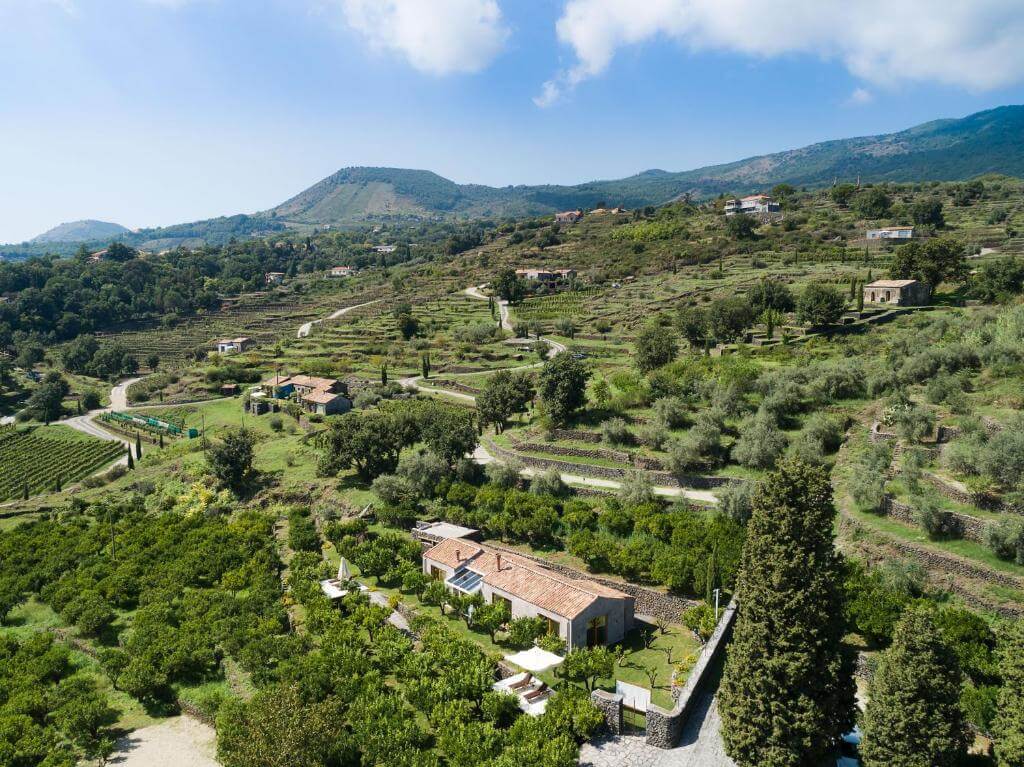 Combining local food and wine with a luxurious countryside vacation is possible in places like Monaci delle Terre Nere.
Combining local food and wine with a luxurious countryside vacation is possible in places like Monaci delle Terre Nere.Conclusion: Why Etna Mountain Should Be on Your Bucket List
Whether you're drawn to the challenge of hiking its rugged slopes, the thrill of witnessing a volcanic eruption, or the opportunity to immerse yourself in the region's culinary and cultural traditions, Mount Etna is a destination that promises to leave a lasting impression.
The mountain's sheer scale, power, and ability to support a diverse and resilient ecosystem make it a true marvel of the natural world.
Beyond its natural wonders, Mount Etna also offers a rich cultural heritage deeply intertwined with the mountain's presence. From the ancient Greek and Roman ruins that dot the landscape to the vibrant festivals and celebrations, the region surrounding Etna is a true treasure trove of history and tradition.
Whether you're seeking a challenging hike, a culinary adventure, or simply a chance to immerse yourself in the awe-inspiring wonder of this volcanic giant, Mount Etna is bound to meet all your expectations.
Related:
Weather in Sicily the Year Round
(This page last edited March 20, 2025)
Recent Articles
-
Sicilian Food - Rich Flavors, Endless Passion
Apr 09, 25 09:54 AM
All you need to know about Sicilian food, its ingredients and history. -
Things to Do in Palermo - Tips for a Perfect Holiday
Apr 05, 25 04:27 AM
Things to Do in Palermo - From historic landmarks to delicious food, this guide has it all. -
The Story of Tommaso Buscetta: From Mafia Boss to Key Witness
Mar 30, 25 05:12 AM
Tommaso Buscetta built Sicilian Mafia into a global empire - which he then destroyed.
Follow MANY FACES OF SICILY on Facebook, Instagram, Bluesky & Pinterest
Contact: vesa@manyfacesofsicily.com

